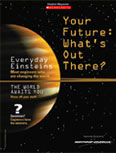| Lesson 3: What's Your Location?
Goals: Practice math skills through problem-solving scenarios and word problems; learn how the Global Positioning System (GPS) and advancements in navigation have an impact on our lives and society
Time Required: 40 minutes
 Materials
Required:What’s Your Location? Student Reproducible 3 (PDF); Resource Sheet 3 (PDF) (found in Part 2 of 2); pencils, pens, library and/or computers with Internet access Materials
Required:What’s Your Location? Student Reproducible 3 (PDF); Resource Sheet 3 (PDF) (found in Part 2 of 2); pencils, pens, library and/or computers with Internet access
Directions:
1. Review the definition of satellite (a celestial body orbiting another of larger size). Explain that man-made satellites receive communication signals from a central source and transmit them to devices such as televisions, radios, and telephones.
2. Discuss how the GPS, operated by the U.S. Air Force, is a network of at least 24 satellites. Ground stations (receivers) precisely track each satellite’s orbit and depend on an accurate measure of time—the satellites are synchronized with atomic clocks at the U.S. Naval Observatory. Each GPS satellite is equipped with an atomic clock and transmits its location and current time.
3. As a class, review how the following facts about how the GPS works:
- GPS receivers receive satellite signals; they do not transmit. When the receivers are getting their signals, they need an unobstructed path to the sky.
- For example, a GPS receiver on a ship receives a signal from one satellite and calculates that the satellite is within an 11,000-mile spherical radius from the receiver. Have students imagine a sphere placed above the receiver and the satellite is at the center of this sphere.
- The GPS receiver receives a signal from a second satellite and calculates that the second satellite is within a 12,000-mile spherical radius, and it is located at one of the four possible points where the two spherical radii intersect.
- The GPS receiver receives a signal from a third satellite and calculates that the third satellite is within a 13,000-mile spherical radius. The receiver triangulates the three intersecting spherical radii and determines that the receiver is located at one of two possible points. Usually this is enough to find the location because one point might be in outer space or on land.
- If needed, a fourth satellite signal gives the receiver the final measurement and finds where the four signals all intersect at one point on the earth with relative accuracy.
- Write the formula Velocity x Time = Distance on the board and review how the receiver uses the velocity of the signal (186,000 mi/sec) and the travel time to determine the distance of the receiver from the satellite.
4. Distribute What’s Your Location? Student Reproducible 3.
5. Have students do additional research about the problems
GPS engineers had to solve to make the system highly accurate.
(Visit www.nasm.si.edu/exhibitions/gps and/or www.trimble.com/gps for interesting facts.)
Answer Key:
1) $12 billion divided by 24 satellites = $500 million each.
2) 15,000 ÷ 186,000 miles/sec, or .0806452. Rounded, it’s .081 seconds. 3) B. 4) 5.9 miles/hour. 5) .51 miles.
Photos, top to bottom: © Denis Scott/Taxi/Getty Images;
© IT Stock Free/PictureQuest.
|


 Materials
Required:What’s Your Location?
Materials
Required:What’s Your Location? 